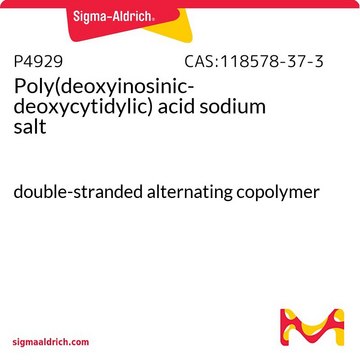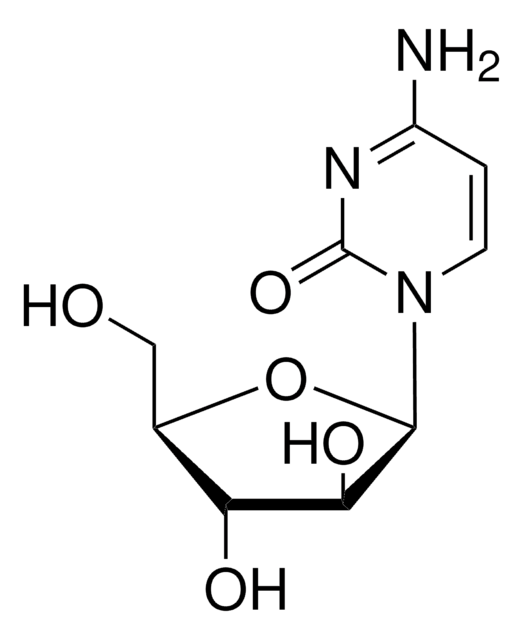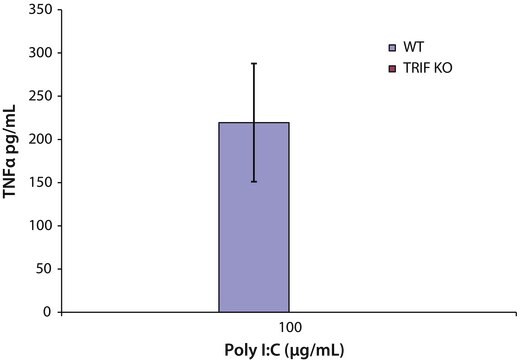P9389
Poly(deoxyguanylic-deoxycytidylic) acid sodium salt
double stranded, alternating copolymer
Synonym(s):
Poly(dG-dC) • Poly(dG-dC)
Sign Into View Organizational & Contract Pricing
All Photos(1)
About This Item
Recommended Products
General description
Poly(deoxyguanylic-deoxycytidylic) acid (poly(dG-dC)) undergoes salt dependent conformational transition. Under high-salt, it exists as a left-handed double helix and at low-salt it displays B-DNA conformation. However on immobilization, poly(dG-dC) takes up A DNA form.
Application
Poly(deoxyguanylic-deoxycytidylic) acid (Poly(dG-dC) • Poly(dG-dC)) is an alternating copolymer, self-complementary, double-stranded DNA model for conformational studies of DNA structure dynamics and drug interaction.
Poly(deoxyguanylic-deoxycytidylic) acid sodium salt has been used:
- in electrophoretic mobility shift assay of transcription factor IIIB complex
- as synthetic copolymers for circular dichroism (CD) spectroscopy studies
- as a positive control in liquid scintillation counting
Other Notes
Alternating copolymer; self-complementary, form double-stranded complex
Unit Definition
One unit will yield an A260 of 1.0 in 1.0 ml 20 mM sodium phosphate/100 mM NaCl, pH 7.0 (1cm light path).
Storage Class Code
11 - Combustible Solids
WGK
WGK 3
Flash Point(F)
Not applicable
Flash Point(C)
Not applicable
Personal Protective Equipment
dust mask type N95 (US), Eyeshields, Gloves
Choose from one of the most recent versions:
Already Own This Product?
Find documentation for the products that you have recently purchased in the Document Library.
Genomic DNA methylation decreases in response to moderate folate depletion in elderly women-
Rampersaud GC, et al.
American Journal of Clinical Nutrition, 72(4), 998-1003 (2000)
Salt-dependent dynamic structure of poly (dG-dC) textperiodcentered poly (dG-dC)
Ramstein J and Leng M
Nature, 288(5789), 413-413 (1980)
TFIIIB subunit locations on U6 gene promoter DNA mapped by site-specific protein-DNA photo-cross-linking
Kang JJ, et al.
Febs Letters, 590(10), 1488-1497 (2016)
Poly (dG)-poly (dC) DNA appears shorter than poly (dA)-poly (dT) and possibly adopts an A-related conformation on a mica surface under ambient conditions
Borovok N, et al.
Febs Letters, 581(30), 5843-5846 (2007)
Ville Laitala et al.
Analytical chemistry, 77(5), 1483-1487 (2005-03-01)
We report here a novel, time-resolved, lanthanide-based energy-transfer assay utilizing nonoverlapping acceptor fluorophores, which have their absorption energetically at a higher level than the emittive transitions of the donor. The technique was studied by comparing a series of nonoverlapping acceptors
Our team of scientists has experience in all areas of research including Life Science, Material Science, Chemical Synthesis, Chromatography, Analytical and many others.
Contact Technical Service
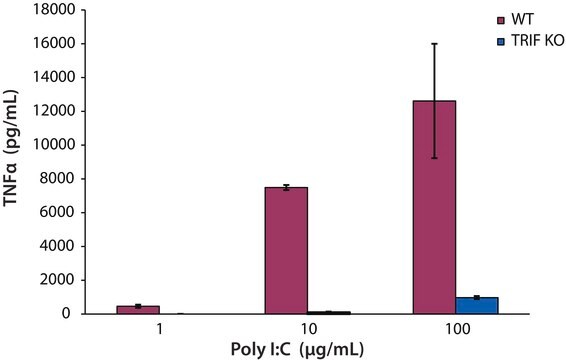


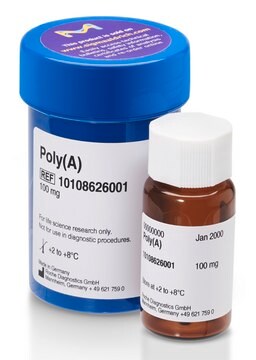
![Poly[d(I-C)] lyophilized, pkg of 10 U (10108812001 [A<sub>260</sub> units]), pkg of 50 U (11219847001 [A<sub>260</sub> units])](/deepweb/assets/sigmaaldrich/product/images/352/091/ef743cea-ccd8-44f1-8f3b-dec5a1e4f5d1/640/ef743cea-ccd8-44f1-8f3b-dec5a1e4f5d1.jpg)
